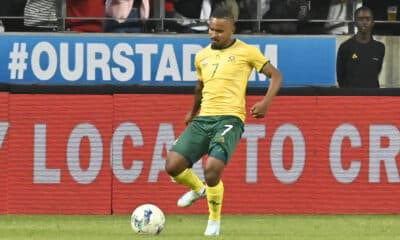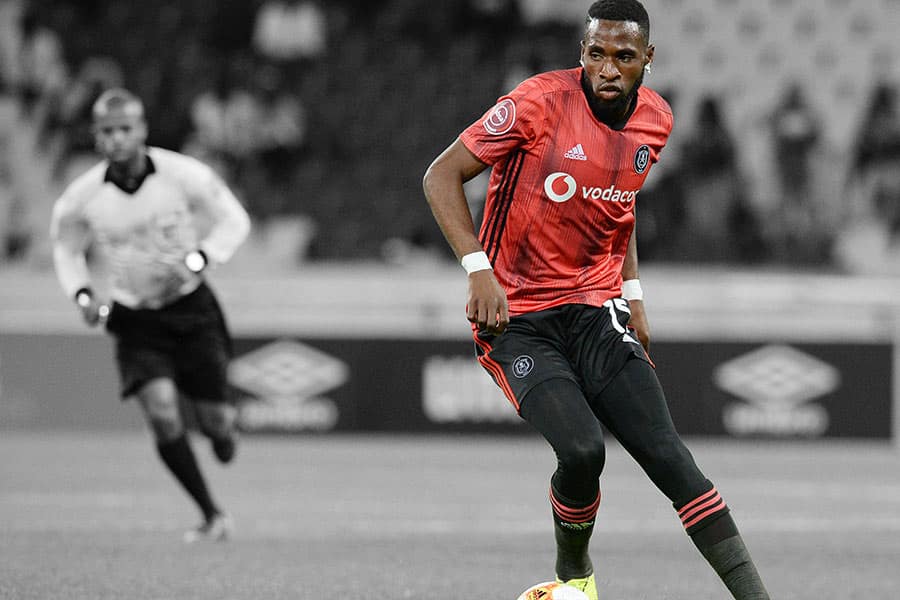
09 September 2019, by: Laduma Analytics
LADUMA ANALYTICS: PSL SQUAD REVIEW
With the Premier Soccer League’s transfer deadline closing at midnight on the 2nd of September, it means South African football teams can not officially trade any more players until the next window in January (except for free agents). Now, with all the trading done, clubs will be looking to buckle down and get ready for what promises to be another testing season for their respective squads.
A few weeks ago, we briefly looked at Mamelodi Sundowns and analysed the squad profile of the defending champions ahead of their quest for a third successive title. The tool/chart we used was an age-utility matrix that plots a club’s squad players according to two metrics – player ages and percentage of PSL regulation minutes each player played last season
Put simply, if the matrix were divided into 4 quadrants – there would be:
-
experienced players, playing a lot of minutes in a season
-
young players, playing a lot of minutes in a season
-
Experienced players, used lightly
-
young players, used lightly
Although lacking experience, a squad made up lots of young players who play regularly and gain experience is preferable when building for the future. On the other hand, a squad heavily reliant on older player may be full of experience, but may not be optimal for the long run. It’s all about finding a balance and this article looks at what balance each team has struck in their recruitment since the end of last season.
We started off with the matrices of a few top teams to get more understanding as to how they have managed their ins and outs, and where that leaves their squads for the 2019/20 season. It should be noted that there are other reasons players may not have played, like injuries, and playing less does not necessarily equate to a player not being considered good enough. The assumption is that 2700 minutes (30 matches in a season x 90 minutes) represents 100% of the time available for a player.
Since the start of the season, Pitso Mosimane has made a few changes to his squad – with Sammy Seabi coming in and the likes on Nyiko Mobbie and Jeremy Brockie going out on loan. Seabi is a young player, aged 24, and featured heavily in the PSL last season, playing two-thirds of minute available (66%).
The additions are notable in that they add youthfulness to a squad we earlier worried was heavily reliant on players aged 30+. George Lebese was a last minute release for the champions as well, a player whose 300 minutes of PSL game time came only after he was loaned to Supersport at the beginning of 2019.
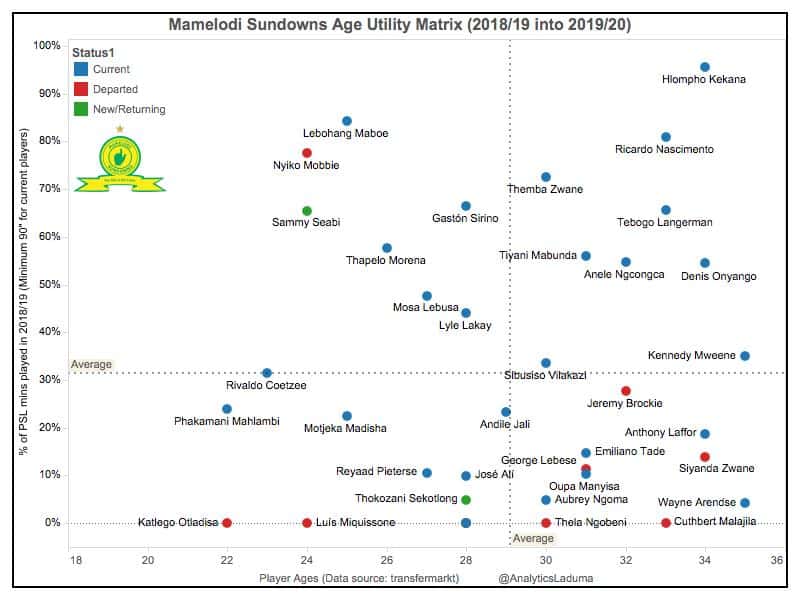
The graph shows how Pitso Mosimane has retained most of the players he used last season, while the majority of players that have departed given on-field minutes less than the average of players on the chart.
Early season form shows that Kekana continues to be the kingpin of this Sundowns side, but questions will soon be asked on how long a team can be built around players on the other side of 30. Seabi has already featured in a league match vs Chippa, while the fit-again Coetzee has shone with a few assists in the opening games. Players like Seabi & Coetzee will need to see more minutes if Sundowns are to have more players in the Top left quadrant all season.
Having missed out so narrowly on the league title at the end of last season, Orlando Pirates have looked to strengthen their squad in key areas as well. The one unexpected departure was the recent resignation of coach Micho, which came as a shock to most South African football followers.
Yet, the Pirates hierarchy have chosen to promote from within and let Rhulani Mokwena lead the team going forward. It remains to be seen if the Buccaneers trust in a young coach will reap rewards, or at least if that will translate to the increased use of young players.
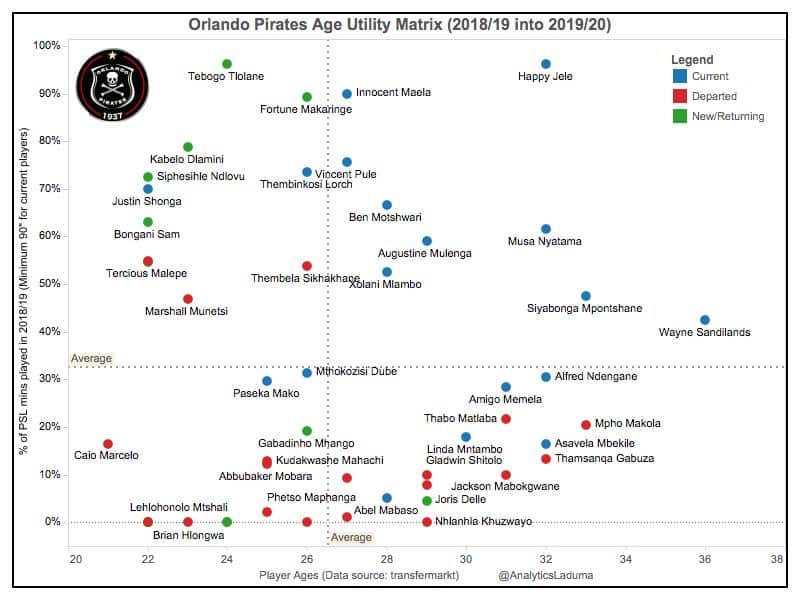
We can see that there has been a lot of movement over the transfer window, with players coming in, including returning from loan spells, and a few going the other way. The return of Tebogo Tlolane from loan at Chippa leaves the new management with a top performer, who was a cut above his peers all of last season.
Tlolane was consistently placed Top Ten among all league players in Challenges and Defensive Challenges won throughout last season while on loan at Chippa, while he also ranked highly in Passes and Accurate passes. (Source: Instat)
Despite a rocky start to the season, Bucs still look to have a well balanced squad with a squad profile that many managers would kill for. A handful of players aged 23 and under who featured heavily in the league last season have signed on for the season, like Ndlovu (72% possible minutes played), Dlamini (79%), Sam (63%) and Mabasa (55%), while older players like Makola, Mobara and Gabuza (all less than 13%) have been released.
You’ve probably heard it a thousand times but 2018/19 was not a great season for Kaizer Chiefs. If anything, it came close to being disastrous. Amakhosi finished 9th in the league – their joint-worst final position in the PSL era, and also amassed their lowest ever points tally (39).
Yet Ernst Middendorp has still gone about his transfer business with the mindset of a man who has faith in his own squad. He continues to put trust in the experienced players like Mathoho, Billiat, Parker and Katsande, and recent comments show that he is eagerly anticipating the return of injured players like Itumeleng Khune to add spark to his side.
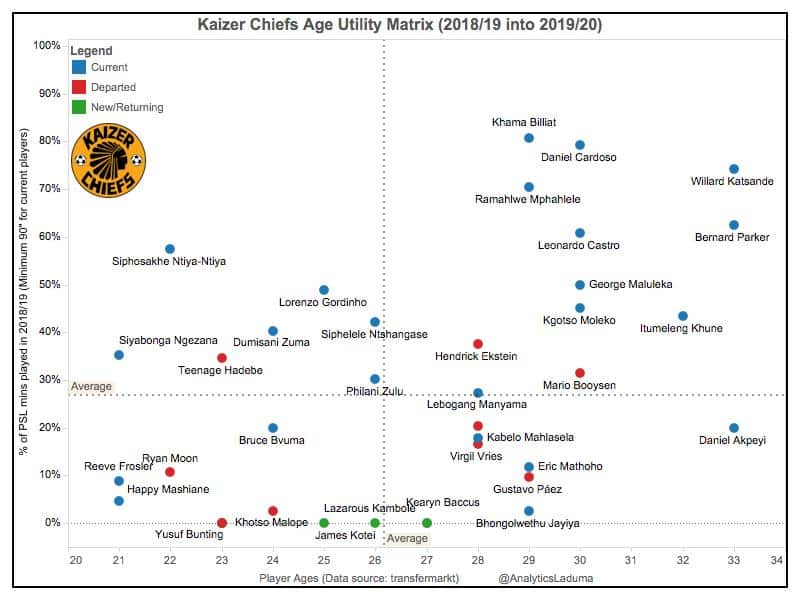
Most of the Chiefs recruitments have come from outside the PSL – Kotei, Kambole, Nurkovic and Baccus, with just two recruited locally. Bunting returns from a loan spell at Highlands Park in which he played a total of two league minutes, while Sasman was recruited from Ajax Cape Town. The squad profile looks like a mixture of experienced PSL players (mostly around the 30-year mark) and a few ready made imports, approaching their peak years.
Early signs have been good for Amakhosi this season, with their 10 points in four games representing an early season return they’ve seen mostly in seasons where they end up as title winners. Nurkovic has stood out with his aerial presence up front, a promising addition to a forward line who misfired last season, resulting in Chiefs ending the season as the sixth lowest-scoring team.
The Glamour Boys know there is still life in the legs of Billiat (30), Manyama (28), Maluleka (30), Mathoho (29) who could be considered to be players at peak age (29-30) rather than aged. Now maybe the time to make the most of their league experience.
After being involved in the title race in long stretches last season, Wits threatened to spoil the two-horse race at some point. However, they fell off in the home stretch as they won just two of nine league matches, including a four-match winless run in early 2019.
Coach Gavin Hunt has added Macheke (25), Nange (27) and Mahangwahaya (30) – mostly young players or players in their peak age to his squad, with Siyanda Zwane (34) the notable outlier. These players together featured in more than 5000 minutes last season. Majoro (32) and Vuyo Mere (35) have been released, older players who played more than 2000 league minutes between the two of them.
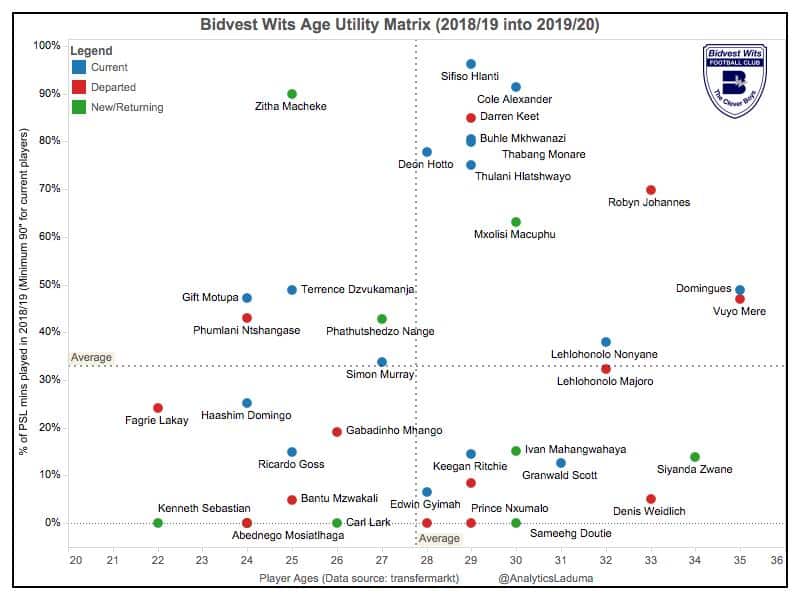
The loss of keeper Darren Keet, Vuyo Mere and the late release of Robyn Johannes could also leave a significant gap in a defence that conceded the joint-third lowest number of goals in the league last season (29).
Like Chiefs, Hunt’s team relies on a core group of players at their peak. The likes of Hlanti, Mkhwanazi, Hotto, Monare, Alexander and Hlatshwayo are between 28 & 30 and are current players that featured in at least 75% of possible minutes last term.
Having held on to important players Motupa and Macuphu, the Clever Boys will be hoping that their recruitments help their stalwarts crack into the Top 2 and maybe reclaim the title they last won in 2017.
MORE SOCCER





















